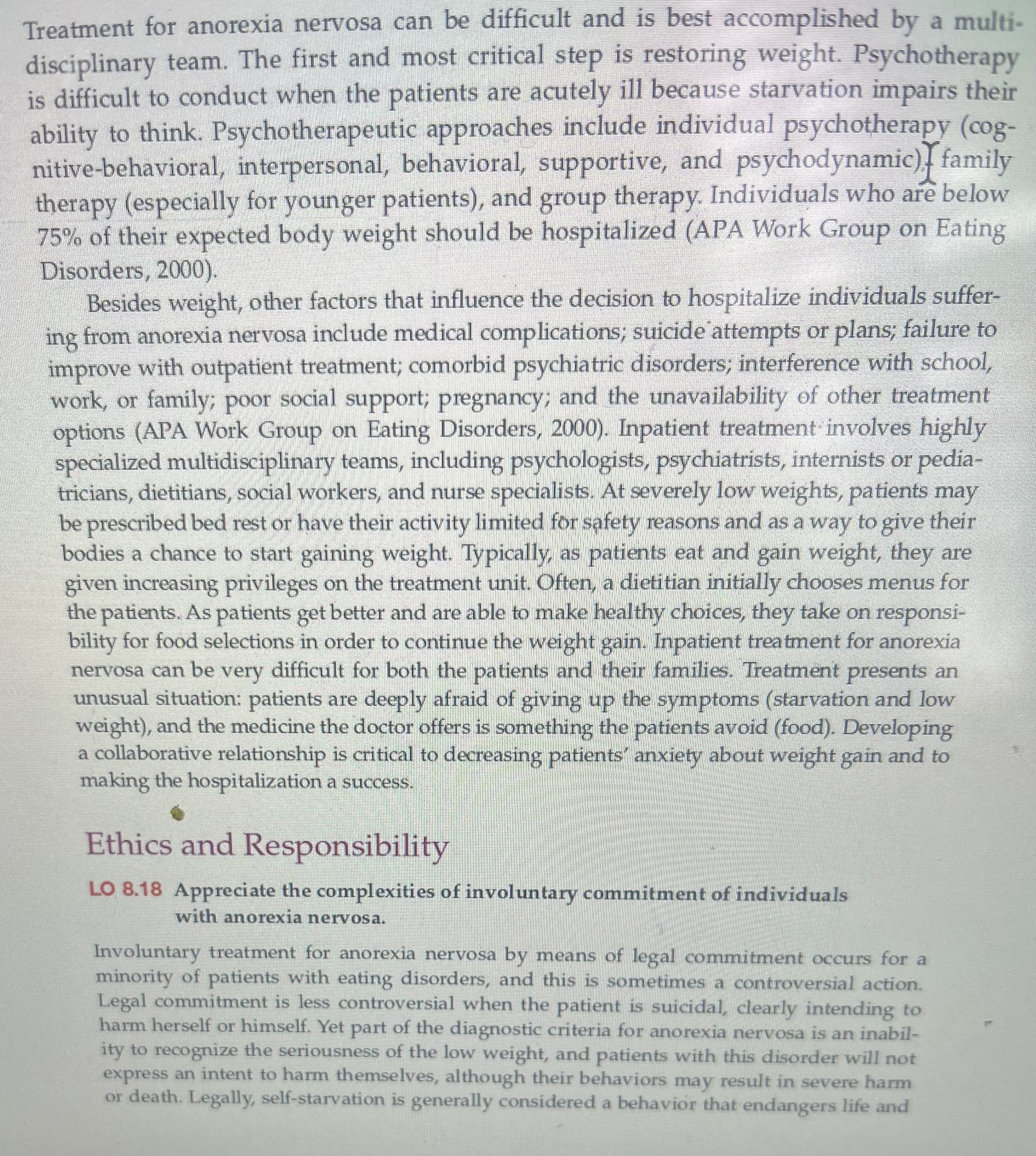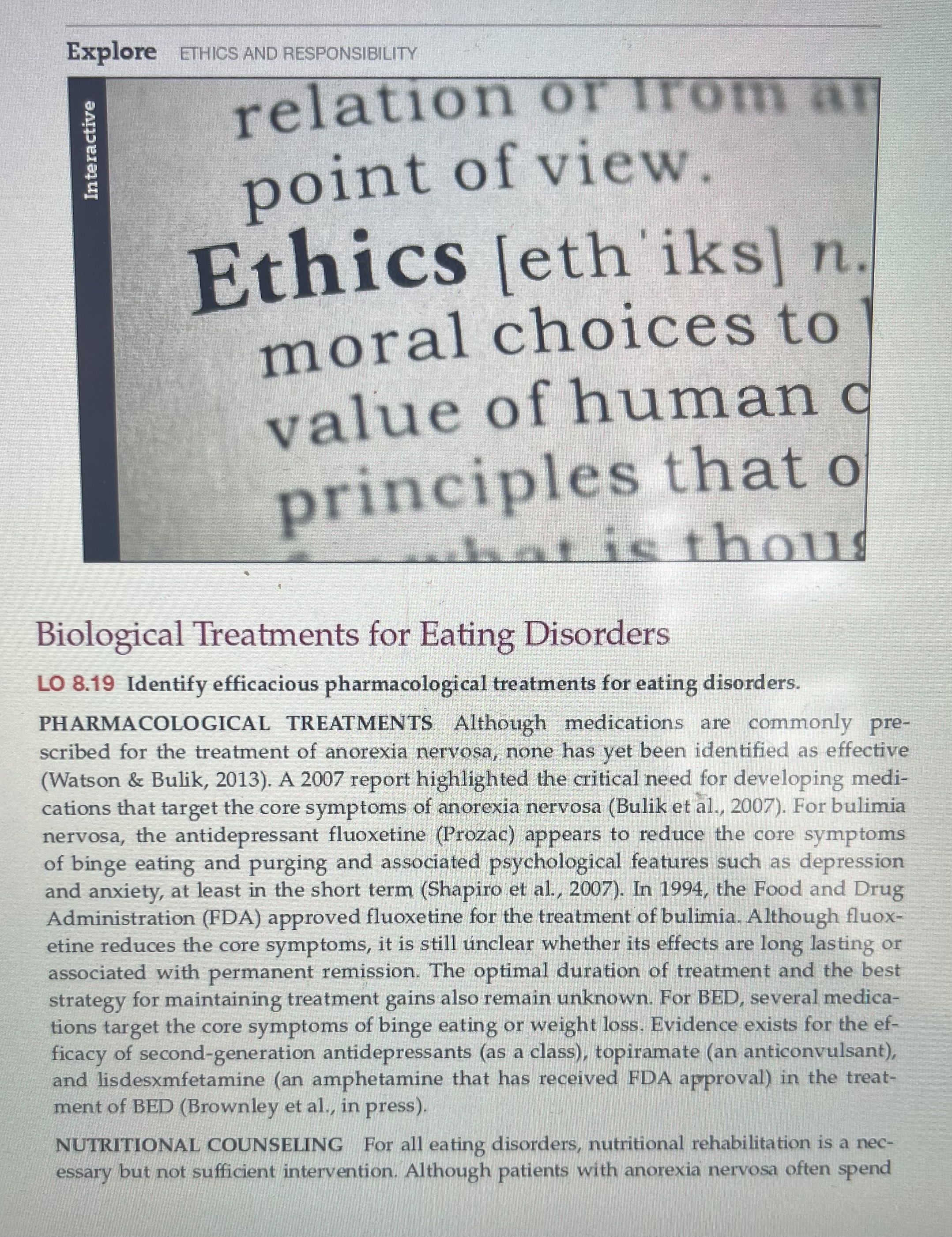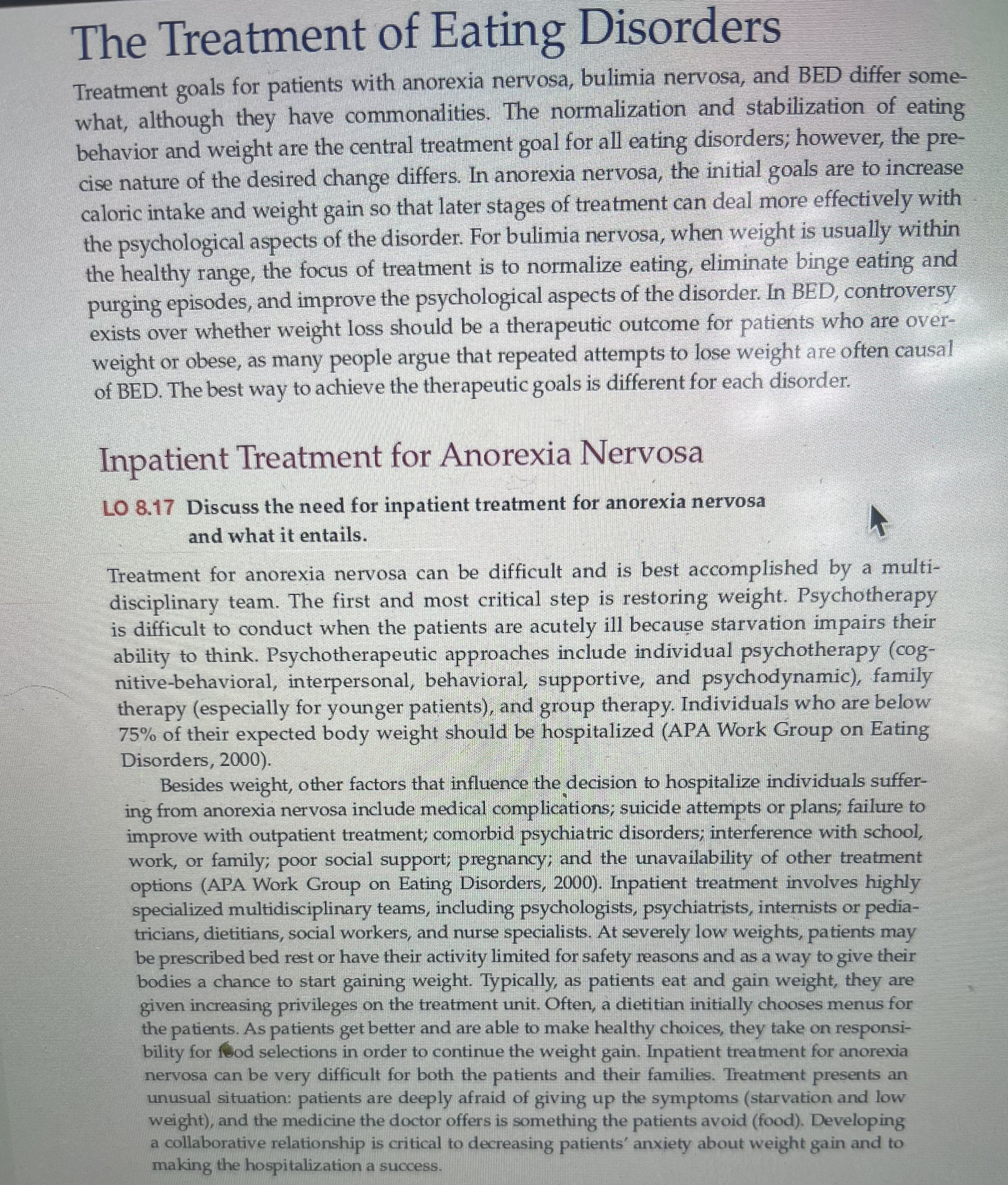Answered step by step
Verified Expert Solution
Question
1 Approved Answer
Treatment for anorexia nervosa can be difficult and is best accomplished by a multi- disciplinary team. The first and most critical step is restoring




Treatment for anorexia nervosa can be difficult and is best accomplished by a multi- disciplinary team. The first and most critical step is restoring weight. Psychotherapy is difficult to conduct when the patients are acutely ill because starvation impairs their ability to think. Psychotherapeutic approaches include individual psychotherapy (cog- nitive-behavioral, interpersonal, behavioral, supportive, and psychodynamic) family therapy (especially for younger patients), and group therapy. Individuals who are below 75% of their expected body weight should be hospitalized (APA Work Group on Eating Disorders, 2000). Besides weight, other factors that influence the decision to hospitalize individuals suffer- ing from anorexia nervosa include medical complications; suicide attempts or plans; failure to improve with outpatient treatment; comorbid psychiatric disorders; interference with school, work, or family; poor social support; pregnancy; and the unavailability of other treatment options (APA Work Group on Eating Disorders, 2000). Inpatient treatment involves highly specialized multidisciplinary teams, including psychologists, psychiatrists, internists or pedia- tricians, dietitians, social workers, and nurse specialists. At severely low weights, patients may be prescribed bed rest or have their activity limited for safety reasons and as a way to give their bodies a chance to start gaining weight. Typically, as patients eat and gain weight, they are given increasing privileges on the treatment unit. Often, a dietitian initially chooses menus for the patients. As patients get better and are able to make healthy choices, they take on responsi- bility for food selections in order to continue the weight gain. Inpatient treatment for anorexia nervosa can be very difficult for both the patients and their families. Treatment presents an unusual situation: patients are deeply afraid of giving up the symptoms (starvation and low weight), and the medicine the doctor offers is something the patients avoid (food). Developing a collaborative relationship is critical to decreasing patients' anxiety about weight gain and to making the hospitalization a success. Ethics and Responsibility LO 8.18 Appreciate the complexities of involuntary commitment of individuals with anorexia nervosa. Involuntary treatment for anorexia nervosa by means of legal commitment occurs for a minority of patients with eating disorders, and this is sometimes a controversial action. Legal commitment is less controversial when the patient is suicidal, clearly intending to harm herself or himself. Yet part of the diagnostic criteria for anorexia nervosa is an inabil- ity to recognize the seriousness of the low weight, and patients with this disorder will not express an intent to harm themselves, although their behaviors may result in severe harm or death. Legally, self-starvation is generally considered a behavior that endangers life and Explore ETHICS AND RESPONSIBILITY Interactive relation or from ar point of view. Ethics [eth iks] n. moral choices to value of human c principles that o what is thous Biological Treatments for Eating Disorders LO 8.19 Identify efficacious pharmacological treatments for eating disorders. PHARMACOLOGICAL TREATMENTS Although medications are commonly pre- scribed for the treatment of anorexia nervosa, none has yet been identified as effective (Watson & Bulik, 2013). A 2007 report highlighted the critical need for developing medi- cations that target the core symptoms of anorexia nervosa (Bulik et al., 2007). For bulimia nervosa, the antidepressant fluoxetine (Prozac) appears to reduce the core symptoms of binge eating and purging and associated psychological features such as depression and anxiety, at least in the short term (Shapiro et al., 2007). In 1994, the Food and Drug Administration (FDA) approved fluoxetine for the treatment of bulimia. Although fluox- etine reduces the core symptoms, it is still unclear whether its effects are long lasting or associated with permanent remission. The optimal duration of treatment and the best strategy for maintaining treatment gains also remain unknown. For BED, several medica- tions target the core symptoms of binge eating or weight loss. Evidence exists for the ef- ficacy of second-generation antidepressants (as a class), topiramate (an anticonvulsant), and lisdesxmfetamine (an amphetamine that has received FDA approval) in the treat- ment of BED (Brownley et al., in press). NUTRITIONAL COUNSELING For all eating disorders, nutritional rehabilitation is a nec- essary but not sufficient intervention. Although patients with anorexia nervosa often spend The Treatment of Eating Disorders pre- Treatment goals for patients with anorexia nervosa, bulimia nervosa, and BED differ some- what, although they have commonalities. The normalization and stabilization of eating behavior and weight are the central treatment goal for all eating disorders; however, the cise nature of the desired change differs. In anorexia nervosa, the initial goals are to increase caloric intake and weight gain so that later stages of treatment can deal more effectively with the psychological aspects of the disorder. For bulimia nervosa, when weight is usually within the healthy range, the focus of treatment is to normalize eating, eliminate binge eating and purging episodes, and improve the psychological aspects of the disorder. In BED, controversy exists over whether weight loss should be a therapeutic outcome for patients who are over- weight or obese, as many people argue that repeated attempts to lose weight are often causal of BED. The best way to achieve the therapeutic goals is different for each disorder. Inpatient Treatment for Anorexia Nervosa LO 8.17 Discuss the need for inpatient treatment for anorexia nervosa and what it entails. Treatment for anorexia nervosa can be difficult and is best accomplished by a multi- disciplinary team. The first and most critical step is restoring weight. Psychotherapy is difficult to conduct when the patients are acutely ill because starvation impairs their ability to think. Psychotherapeutic approaches include individual psychotherapy (cog- nitive-behavioral, interpersonal, behavioral, supportive, and psychodynamic), family therapy (especially for younger patients), and group therapy. Individuals who are below 75% of their expected body weight should be hospitalized (APA Work Group on Eating Disorders, 2000). Besides weight, other factors that influence the decision to hospitalize individuals suffer- ing from anorexia nervosa include medical complications; suicide attempts or plans; failure to improve with outpatient treatment; comorbid psychiatric disorders; interference with school, work, or family; poor social support; pregnancy; and the unavailability of other treatment options (APA Work Group on Eating Disorders, 2000). Inpatient treatment involves highly specialized multidisciplinary teams, including psychologists, psychiatrists, internists or pedia- tricians, dietitians, social workers, and nurse specialists. At severely low weights, patients may be prescribed bed rest or have their activity limited for safety reasons and as a way to give their bodies a chance to start gaining weight. Typically, as patients eat and gain weight, they are given increasing privileges on the treatment unit. Often, a dietitian initially chooses menus for the patients. As patients get better and are able to make healthy choices, they take on responsi- bility for food selections in order to continue the weight gain. Inpatient treatment for anorexia nervosa can be very difficult for both the patients and their families. Treatment presents an unusual situation: patients are deeply afraid of giving up the symptoms (starvation and low weight), and the medicine the doctor offers is something the patients avoid (food). Developing a collaborative relationship is critical to decreasing patients' anxiety about weight gain and to making the hospitalization a success. constitutes a grave disability, thereby allowing civil commitment of patients with severe anorexia who refuse treatment (Applebaum & Rumpf, 1998). Patients with anorexia nervosa show equivalent rates of weight gain during hospital- ization whether they enter the hospital voluntarily or involuntarily as a result of a legal commitment process. Moreover, when asked later, patients who were committed involun- tarily commonly report that their involuntary treatment was justified and view their treat- ment teams with good will (Watson et al., 2000). In principle, involuntary commitment should be viewed as an approach of last resort only after patients decline voluntary hospi- talization, when their physical safety is at risk, and when there is likely to be therapeutic gain from hospitalization (Applebaum & Rumpf, 1998). Discussions and clinical trials are emerging that explore how best to treat individuals with severe and enduring eating disorders (SE-ED) for whom multiple interventions fail to effect cure. A recent RCT of outpatient psychotherapy supported a shift of focus from weight regain and recovery to a therapeutic goal of improved quality of life (Touyz et al., 2013).
Step by Step Solution
There are 3 Steps involved in it
Step: 1

Get Instant Access to Expert-Tailored Solutions
See step-by-step solutions with expert insights and AI powered tools for academic success
Step: 2

Step: 3

Ace Your Homework with AI
Get the answers you need in no time with our AI-driven, step-by-step assistance
Get Started


